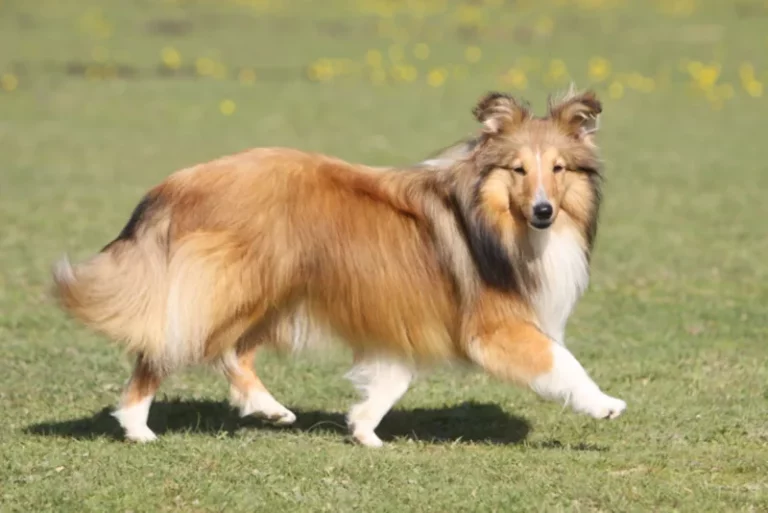Things to Know About Shetland Sheepdog Dog Breed Information
The Shetland Sheepdog, often known as the Sheltie, is an intriguing example of beauty and utility combined in one breed. Originating from the harsh conditions of the Shetland Islands, the Sheltie looks a lot like the Rough Collie. It is known for its smartness, speed, and faithfulness, making it an excellent working dog and a loyal friend.
The breed’s long history and ability to adapt prompt us to consider how the environment influences a dog’s behavior and physical features. Breeders and owners also play a significant role in ensuring these dogs stay healthy and happy.
When we look closely at the temperament of the Shetland Sheepdog and the details of its care, we get a better idea of the responsibilities involved in looking after this unique and beloved breed.
Key Takeaways
- Shetland Sheepdogs are small-to-medium sized dogs with a compact, muscular frame and a thick double coat in various colors.
- They are smart, easy to train, and have strong herding instincts, making them excel in obedience and agility sports.
- Shetland Sheepdogs originated from the Shetland Islands and were selectively bred for their herding skills, adapting to the harsh conditions of the islands.
- Proper nutrition, regular exercise, and mental stimulation are essential for their overall well-being and longevity.
Quick Facts
The Shetland Sheepdog, often called a Sheltie, is a small-to-medium-sized dog that weighs between 15 and 25 pounds and stands about 13 to 16 inches tall. These dogs are intelligent, making them easy to train. They come from the Shetland Islands in Scotland, where they were used for herding.
The American Kennel Club recognizes them for their skills in agility and obedience, and their herding talent is a nod to their past.
Shelties live for about 12 to 14 years and have a thick coat in several colors, including sable, tricolor, blue merle, and bi-black. Owners need to groom them often. They are sturdy dogs, which means they do well in various dog activities and can be suitable for therapy work.
Shetland Sheepdog Dog Breed
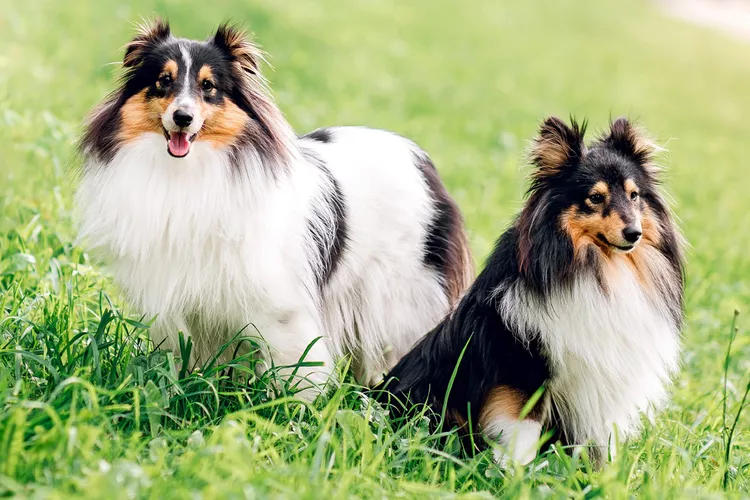
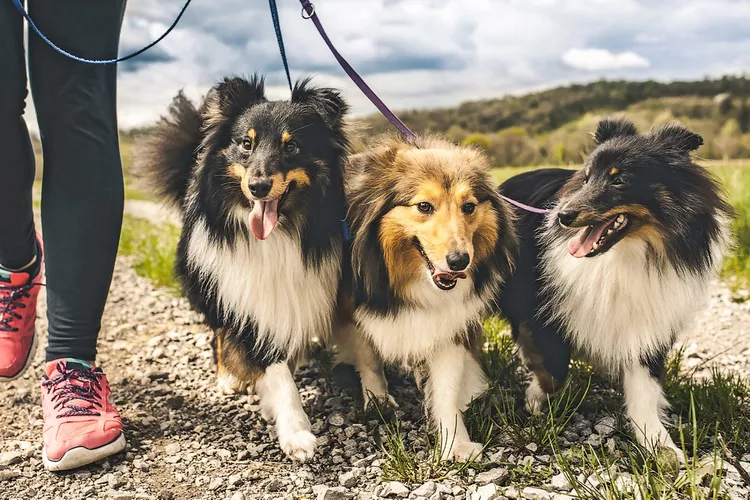
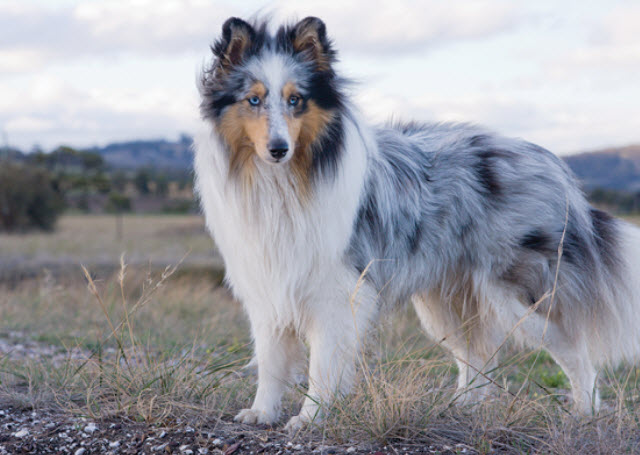
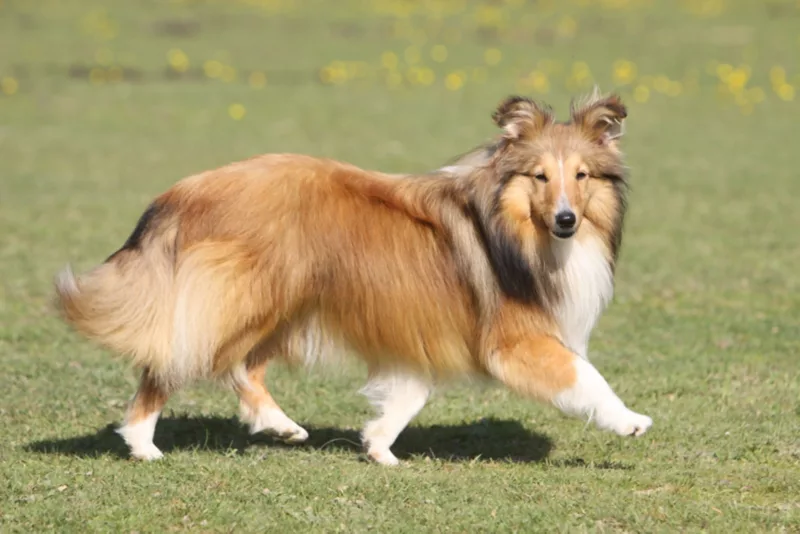
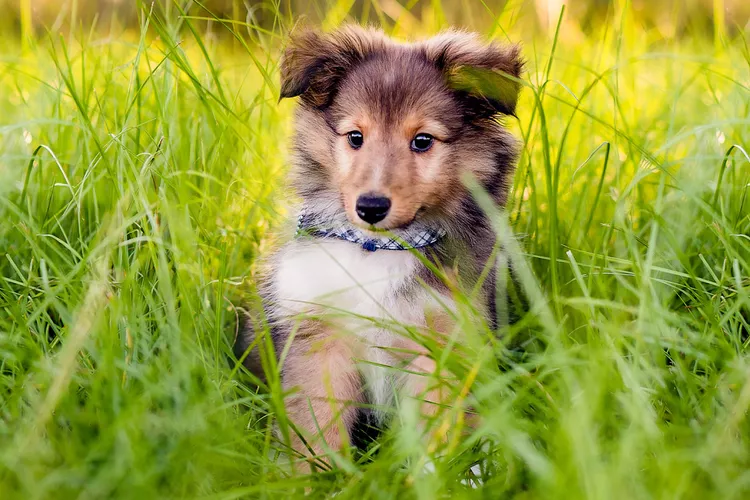
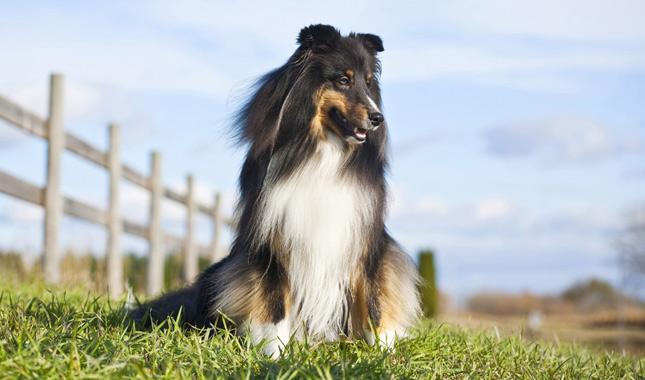
Overview
Renowned for their sharp intellect and agility, Shetland Sheepdogs exhibit characteristics that make them highly esteemed within the Herding Group of canine breeds.
Originating from the Shetland Islands of Scotland, these small to medium-sized canines demonstrate a high degree of trainability and adaptability, characteristics vital to herding breeds.
With a life expectancy of 12-14 years, the breed’s alert and gentle demeanor aligns with its physical attributes, which include a height range of 13-16 inches and a weight of 15-25 pounds.
The Shetland Sheepdog’s double coat, which comes in sable, tricolor, blue merle, and bi-black, necessitates regular grooming to maintain its condition.
These dogs are compatible with family environments and are well-suited to novice owners, requiring moderate exercise to remain fit and responsive.
Key Sheltie Traits
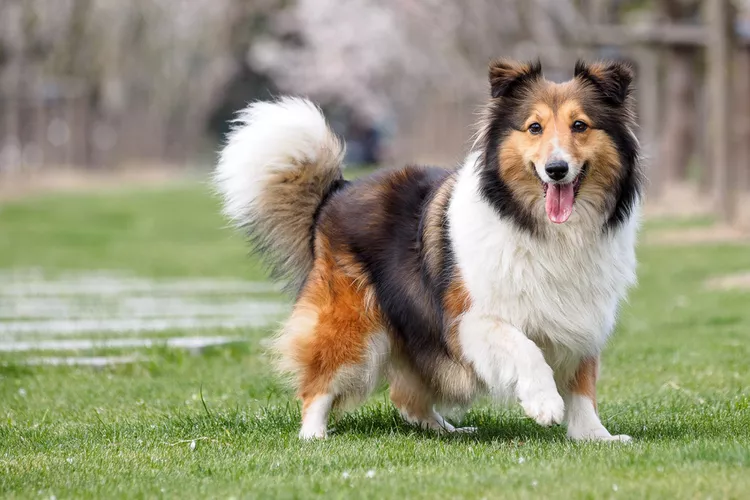
Shetland Sheepdogs, often admired for their looks, have notable behavioral and physiological traits. These dogs are brilliant, which makes them easy to train and good at solving problems. They have strong herding instincts, which can be seen when interacting with other animals and people, as they naturally try to organize and direct movement.
Their double-coated fur is perfect for keeping them warm in the cold and excellent in the heat, but it does need regular grooming. Regular care is required to keep their coat in good shape and reduce shedding. Here’s a quick overview of the Shetland Sheepdog’s main qualities:
| Trait | Description | Relevance |
|---|---|---|
| Herding Instincts | This relates to their smartness and ability to work | It makes them easy to train and versatile |
| Intelligence | Quick to learn and understand | A thick under-layer and a more extended top layer |
| Double Coated | It keeps them comfortable in different weather and requires upkeep | Keeps them comfortable in different weather and requires upkeep |
Shetland Sheepdogs are charming in appearance and possess a suite of abilities that make them standout pets. Their quick wits and natural herding behavior make them great companions, especially for those who appreciate an active and intelligent dog. Remember, their luxurious coats need extra attention, so be ready for grooming sessions with your Sheltie.
Origins and Ancestry of Pet Parents
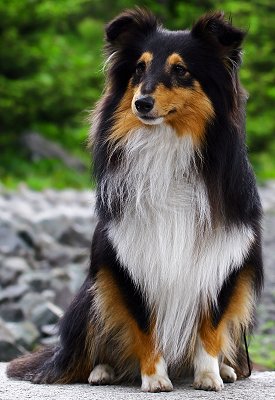
The Shetland Sheepdog has a fascinating history that began in the Shetland Islands. This dog breed showcases characteristics that its environment and its ancestors have shaped. A close look at the breed shows that it was bred selectively for herding skills and to thrive in the harsh conditions of the islands. The remote location of their origin played a massive part in developing their distinct size and fur.
Tracing the breed’s ancestry reveals a mix of Collie and Spaniel bloodlines. The timeline of the breed’s growth is a testament to its adaptation to the specific weather and landscape of the Shetland Islands. The breed’s geographic roots are crucial in understanding the development of its small stature and dense coat.
The Shetland Sheepdog’s herding prowess is the result of targeted breeding efforts. Despite these changes, the breed has kept ancestral qualities such as intelligence and agility.
Ancestral Lineage Tracing
The heritage of the Shetland Sheepdog is rich and varied, tracing back to the Shetland Islands, where the breed was first developed for herding. Over the years, the species has undergone careful breeding and selection, resulting in the Shetland Sheepdogs we know today.
Research into this breed’s past has highlighted its progression, with the Shetland Islands identified as the birthplace of these capable herding dogs. Species like the rough Collie have influenced the Shetland Sheepdog, giving them recognizable appearances and behaviors.
Understanding their ancestry is critical for breeders dedicated to maintaining the breed’s purity and promoting genetic health. Knowledge of the breed’s heritage is vital for addressing inherited health concerns and ensuring the continuation of desirable traits. This insight gives breeders the tools to make informed decisions to sustain the Shetland Sheepdog’s quality and genetic variety.
Breed Development Timeline
Understanding the Shetland Sheepdog’s origins, we see its transformation from a regional herding dog to a breed celebrated globally.
Originally called the Shetland Collie, this breed was shaped by the harsh environment of the Shetland Islands. Its ancestors include miniature Scottish Collies, the King Charles Spaniel, and a significant Rough Collie brought in by James Loggie.
The England Kennel Club officially recognized the Shetland Sheepdog in 1909, and the American Kennel Club did the same in 1911. The breed made its way to mainland Scotland in the early 20th century, gaining fame and affection outside its native islands.
Geographic Origin Impact
Shetland Sheepdogs come from the Shetland Islands in Scotland, carrying distinctive features due to their origin and ancestry. These dogs were bred to manage herds on challenging terrains under variable weather, which made them rigid and flexible. Their bodies and abilities reflect the demanding conditions of their homeland. They look like smaller Collies because people on the islands bred them for effective herding.
Their coat colors and behaviors show the Shetland Islands’ history and the challenges they faced, helping us understand the breed’s evolution and characteristics.
The Shetland Sheepdog’s physical traits and herding skills directly result from the challenging Shetland environment. Island breeders focused on herding abilities, which explains why these dogs resemble miniature Collies.
The coat colors and behaviors of the breed reveal much about the historical and environmental influences of their island home, giving us a clearer picture of their development and current qualities.
Shelties Stature and Build
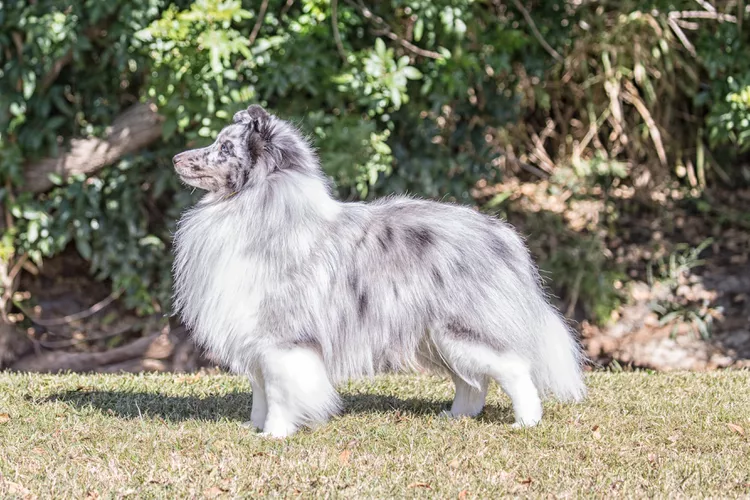
The Shetland Sheepdog presents a harmonious blend of size and power, with a stature that lends itself to agility and sturdiness. Their physique is characterized by a well-balanced structure that affords them a gait combining grace and efficiency. Detailed examination of their build reveals several key points:
- Typical height ranges from 13 to 16 inches at the withers.
- Average weight fluctuates between 15 to 25 pounds, aligning with their overall size.
- Physical characteristics include a compact, muscular frame with a deep chest and level back.
- Athleticism and agility are evident in their graceful movements and endurance.
- Body proportions are meticulously defined, ensuring a well-proportioned silhouette.
Typical Height Range
Shetland Sheepdogs stand at a height of 13 to 16 inches, showing a slight to medium firm and compact build. Their body contributes to their agility, especially when herding.
Weighing in at 15 to 25 pounds, these dogs fit well in city apartments and large country homes. They’re versatile, which makes them great for various activities, including dog sports, where speed and flexibility are critical.
Shelties move quickly and easily, precisely what’s needed for herding work and dog sports competitions.
Average Weight Details
Shetland Sheepdogs, known as Shelties, typically weigh between 15 to 25 pounds. Their size suits their agile nature, making them adaptable to various home settings. Shelties are small but sturdy dogs, with males usually heavier than females, showing a common sexual dimorphism in the breed.
Their double coat is a defining trait that needs regular grooming to keep them healthy and looking good, which can also affect how heavy they seem. These aspects make Shelties an ideal, easy-to-manage pet for many households.
Physical Characteristics
Shetland Sheepdogs are small to medium-sized, sturdy dogs standing about 13 to 16 inches tall and weighing 15 to 25 pounds. They have a double coat with rough outer and soft inner layers, keeping them warm in cold weather.
The unique blue merle color is just one of the coat patterns found in Shetland Sheepdogs, with others including sable, tricolor, and bi-black. Males tend to be larger than females, but both sexes are solidly built.
Shaving their coats is a bad idea because it can cause hair loss and ruin their insulation against the cold. Regular grooming is essential, especially when shedding, to keep their coat healthy and avoid skin problems.
Athleticism and Agility
Shetland Sheepdogs, known as Shelties, are agile and quick, making them excellent at dog sports and herding. They weigh 15-25 pounds and stand 13-16 inches tall, with a muscular build ideal for activities requiring quickness and stamina. Their double coat, which has a rough outer layer and a soft underlayer, protects them against weather conditions, helping them stay agile.
Shelters, from young puppies to grown dogs, need regular mental and physical workouts to stay fit for herding and agility competitions. Their exercise routines keep them in peak condition, ready to tackle any physical challenge with grace and speed.
Body Proportions Explained
The Shetland Sheepdog, often known as the Sheltie, is a breed with a well-balanced and robust physique. Its body is perfectly proportioned to its size, crucial for the herding tasks it was bred to perform. Originating from the harsh and windy Shetland Islands, these dogs adapted to become smaller than their Collie cousins.
Shelties stand about 13-16 inches tall at the shoulder, which makes them quick and agile. They usually weigh 15-25 pounds, adding to their ease of movement. Their thick coat, featuring a tough outer layer and a soft undercoat, is suited for cold environments.
Meeting the breed’s exact size, weight, and ear shape standards is essential for dog shows. Over time, shelters have become smaller, a testament to their ability to thrive in demanding conditions and maintain their working dog traits.
Temperament Behavioral Characteristics
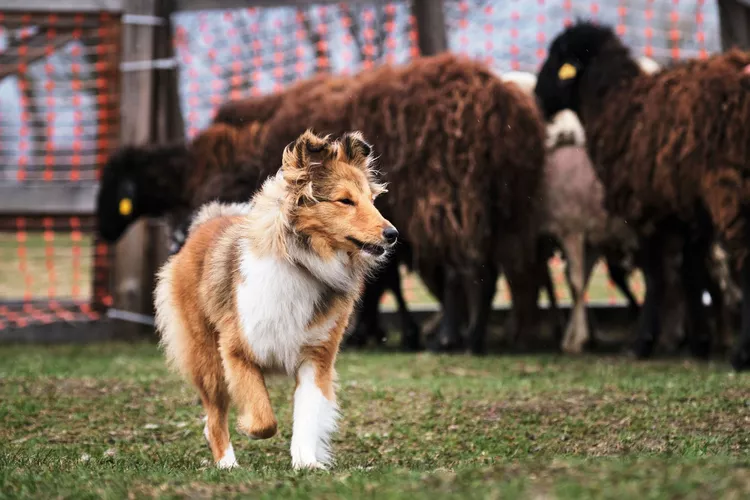
The Shetland Sheepdog is known for specific behaviors that come from both their genes and their upbringing. These dogs naturally want to herd, are often vocal, and learn quickly, making them easy to train. Owners must recognize these traits to meet the dogs’ needs and keep them happy at home or elsewhere.
Shelters often show their herding skills by circling and sometimes gently nipping. They communicate with their voices and can bark quite a bit. These dogs are brilliant, which makes them a breeze to train and great at figuring things out. They need a lot of exercise because they have so much energy.
Shelters are loyal and loving, but they might be a bit shy around new people.
Herding Instincts
Shetland Sheepdogs, or Shelties, show assertive herding behavior, keenly watching for movement and quickly reacting to commands to direct their group. These dogs naturally perform actions such as surrounding, crouching, and gently pushing with their noses, a trait inherited from their working ancestors.
These instincts can surface at home, where they may try to herd kids, other animals, or even objects, thinking of them as their flock. Proper training can channel these impulses into organized activities like agility sports or herding competitions.
Shelties are also watchful and protective, making them excellent guard dogs and loyal family members.
Vocal Communication Traits
Shetland Sheepdogs, known for their communication skills, use a range of sounds to interact with people. They bark to warn about danger or changes in their surroundings and show excitement when they need attention.
Because Shelties are very sensitive, they might bark too much if bored, anxious, or not stimulated enough. Training and interactive activities are necessary to manage this.
They also howl when alone, showing they need company and want to please. Paying attention to their sounds can make the relationship between dogs and owners stronger and better.
Intelligence and Trainability
Shetland Sheepdogs shine in obedience and agility, recognized for their smarts and ease of training. They’re the sixth most intelligent dog breed, a testament to their mental prowess. They can pick up a new command after a few tries, often needing only five repetitions to learn something new.
Their instincts to herd make them stand out in canine sports, especially herding competitions. But it’s not all about sports – their intelligence and friendly disposition make them excellent therapy dogs.
Exercise and Activity Needs
Shetland Sheepdogs, commonly known as Shelties, thrive on a balanced exercise routine. They need about 30 to 60 minutes of daily activity for their health. This should include both physical conditioning and mental challenges. Due to their herding background, such as herding simulations, Shelties benefit from games that tap into their instincts.
These dogs are skilled in various dog sports, such as agility, obedience, and showmanship. Therefore, they need diverse exercise routines to stay happy and healthy. Taking them for daily walks is vital. It helps keep them fit and provides mental stimulation as they explore new scents and sights.
When Shelties are around their kind, they often show sudden, energetic spurts, known as ‘Zoomies.’ This behavior highlights the importance of regular playtime and exercise to channel their abundant energy.
Social Behaviors
Exercising and staying active are vital for the health of Shetland Sheepdogs, but it’s just as critical to understand their social behaviors to ensure they are happy and fit well into their homes. Shetland Sheepdogs show a range of behaviors that owners should get to know. These intelligent dogs are among the top performers in intelligence tests, often ranking 6th out of 138 breeds. Because of their smarts, they learn quickly, excel in obedience, and are great at agility courses. Mental exercises are a must to go along with their need for regular physical activity.
Shelters are instinctive to protect their homes and bark to alert their owners of anything unusual, making them excellent watchdogs. It’s crucial to expose them to different situations and people early on; a Sheltie used to various environments tends to be friendly with kids and meshes well with the household. They can be wary of strangers, so guiding them in these encounters is essential.
Wellness and Longevity of Miniature Collie
To ensure the well-being and longevity of Shetland Sheepdogs, we must focus on essential health factors. Health check-ups are crucial as they help catch and manage inherited conditions and diseases that come with age. A well-rounded diet explicitly designed for them and regular exercise is critical to keeping them healthy for years to come.
Health check-ups can reveal genetic risks and help prevent certain diseases common in this breed. Nutrient-dense food is vital for their metabolism and keeps their energy up. Consistent physical activity is great for their heart and muscles. Engaging their minds with different actions can prevent behavior problems. Taking care of their teeth is also essential to avoid gum disease, which can impact their overall health.
- Health check-ups are essential for spotting genetic issues early on.
- Proper nutrition is necessary for their metabolic health and energy.
- Exercise is essential for solid hearts and muscles.
- Mental stimulation helps prevent behavioral problems.
- Good dental care prevents gum disease and protects overall health.
Shetland Sheepdog Health Screening Importance
Regular health check-ups are critical for Shetland Sheepdogs to maintain their health and increase their life expectancy. These evaluations are crucial to catching and managing health issues common to the breed early on. Health screenings help spot genetic diseases early so we can start treatment sooner.
For example, hip dysplasia is a genetic problem many dog breeds face, but it can be spotted early with hip X-rays. Eye exams and tests for thyroid function are also vital for keeping an eye on other common health problems in Shelties.
Sticking to a schedule of preventive health checks can help stop diseases from getting worse and help these dogs live longer, healthier lives through quick medical care.
Diet for Longevity
A healthy diet is vital to a long, happy life for Shetland Sheepdogs. These small, energetic dogs need a mix of lean meats or fish to keep their muscles strong and their bodies working well. Including various fruits and vegetables in their meals is also essential to give them the micronutrients and natural compounds they need for a robust immune system and good metabolism.
Shelties thrive on a diet that provides the right balance of carbohydrates and fats for energy and health. It’s also good to give them probiotics in their food or as a supplement to keep their digestive system in top shape. This can help them live a fuller, healthier life.
Owners should be careful not to feed them too much processed food or rancid fats, which can lead to obesity and illness, so that they can enjoy their furry companions for many years.
Regular Exercise Benefits
A good diet is vital for the health and long life of Shetland Sheepdogs, but exercise is just as critical for their well-being and longevity. Making sure a Sheltie gets plenty of activity is crucial to keep them at a healthy weight and prevent health issues related to obesity.
Exercise strengthens the heart, making it more efficient and reducing the risk of heart problems. It also boosts mental health by releasing endorphins, which reduce stress and improve mood.
Regular physical activity improves muscle strength, joint flexibility, and bone density, all important for a dog’s long life and quality of life. It also strengthens the immune system, reducing the chance of chronic illnesses and helping them live longer.
Sheltie Maintenance Essentials
Caring for a Sheltie involves a dedicated routine that caters to their unique needs. These dogs have a thick coat and a zest for life, so it’s essential to have a structured plan covering their physical and mental requirements. Here are the critical elements of Sheltie care that help them live a happy and healthy life.
Grooming Essentials
Regular brushing is a must for Shelties due to their thick coats. This helps prevent mats and keeps their fur in good condition. Bathing them every few months or as needed will keep their skin clean and reduce shedding.
Nutrition Tips
Feeding your Sheltie high-quality food is vital for their health. Look for brands that use wholesome ingredients and avoid fillers. Ensure their diet is rich in proteins and nutrients to support their energy levels.
Exercise Needs
Shelters have plenty of energy and need daily exercise to stay fit. This can include walks, playtime, or agility training. Keeping them active also stimulates their mind, which is just as important as physical health.
Health Check-ups
Regular vet visits are essential to catch any health issues early. Keep an eye on their dental health, vaccinations, and parasite control. A proactive approach to their health can prevent many common problems.
Training Methods
Shelties are intelligent and respond well to positive reinforcement training. Consistency is vital in teaching them new commands and good behavior. Engaging them with training strengthens your bond and keeps their mind sharp.
Double Coate Grooming Routine Basics
To keep a Shetland Sheepdog healthy, a thorough grooming routine is vital. Their double coat must be brushed weekly with tools like a pin brush. This helps prevent matting, especially behind the ears and under the collar.
Regular ear checks and cleaning are essential to avoid infections. The dog’s nails should be clipped every two weeks to prevent problems from nails that are too long.
When it comes to baths, use shampoos made for dogs, and dry the coat well to prevent skin issues. Taking care of their teeth with frequent brushing and looking for skin problems is vital to keeping them healthy and happy.
Optimal Nutrition Practices
Ensuring that Shetland Sheepdogs receive a balanced diet is vital to their well-being and energy levels. Choosing a premium dog food that caters to the needs of more miniature to medium-sized dogs is essential. A diet that provides all the necessary nutrients is crucial, including proteins to support muscle health, fats for energy, carbs for endurance, and vitamins and minerals for overall bodily functions.
It’s vital to significantly tailor their calorie intake to their activity level since Shetland Sheepdogs can quickly gain excess weight.
Regular check-ups with a vet or a dog nutritionist are vital. They can offer personalized advice based on your dog’s health and lifestyle. This helps ensure your Shetland Sheepdog stays in top condition, with a diet that meets their needs.
Exercise and Activity Levels
Shetland Sheepdogs, or Shelties, are energized and require daily exercise to keep their bodies and minds healthy. A routine that includes 30 to 60 minutes of physical activity is ideal for them. These active dogs do well with structured play, such as walking, frolicking, and enjoying free running in safe environments.
Incorporating games that tap into their herding instincts ensures they get the mental and physical workout they need. It’s easy to see their zest for life when Shelties get the zoomies, those sudden bursts of energy. They’re also naturally good at dog sports, where they can show off their agility and knack for following commands.
Activities like flyball, tracking, and herding meet their exercise needs and suit their intelligent and trainable nature.
Health Monitoring Tips
For Shetland Sheepdogs, getting enough exercise is vital to staying fit. But monitoring their health closely with regular maintenance is just as critical.
Sheltie owners should make sure their pets get checked by the vet often. Starting when the dogs are just weeks old helps track their health and ensure they get their shots on time.
Paying close attention to their eyes is also vital. If you notice any irritation or redness, check it immediately. Regular eye tests can catch any inherited eye problems early on.
Taking care of their coat is another must-do. Regular grooming prevents tangles and keeps their skin healthy.
Watching their weight is also a big deal. Staying on top of any weight gain can help avoid health issues like hip dysplasia, which is linked to obesity.
It’s also wise to keep an eye on how they behave. Any changes might be a sign of hidden health problems.
Behavioral Training Techniques
Shetland Sheepdogs, or Shelties, thrive when they’re trained with effective behavioral techniques. These methods help them learn obedience and build a strong bond with their owners. For the best results, it’s essential to use reward-based training that suits the Sheltie’s natural tendencies. This means giving treats or praise when they do something right and taking away something they like when they do something wrong.
To train a Sheltie well, you must be consistent and clear when you give commands. Shelties are excellent at catching small changes in your act or sound. That’s why it’s best to start training them when they’re young. This takes advantage of their ability to learn quickly at a young age.
If a Sheltie is scared of something, use a gradual approach to help them get used to it. This can make them feel more comfortable in different places and other things around them.
Shelties Need Nutritional Requirements and Diet Tips
The health and longevity of Shetland Sheepdogs strongly depend on their diet. A well-balanced diet is crucial in preventing nutritional deficiencies and keeping obesity at bay. Proper feeding habits, like how often and how much they eat, are essential to maintaining these dogs healthy and energetic.
High-quality dog food with plenty of protein is needed for their muscles and overall health. It’s important to watch how much they eat to avoid excess weight, which can lead to health problems. Feeding them smaller meals throughout the day can help with better digestion and consistent energy levels.
Knowing if your dog has any food allergies is essential to avoid harmful reactions. Consulting with a vet can help create the proper diet for your dog’s needs.
Balanced Diet Essentials
A Shetland Sheepdog needs a balanced diet with the right mix of proteins, fats, carbs, vitamins, and minerals to stay healthy and full of energy. Getting the balance right is critical, especially for small breeds with unique needs.
A vet can help tailor a diet perfect for your dog’s size, growth stage, and health issues.
The best dog foods for small to medium dogs have all these nutrients in spades. Keeping an eye on your dog’s diet and weight is crucial. You should avoid giving them human food high in calories but low in nutrients. This helps prevent weight problems and the health issues that come with them.
Feeding Frequency Recommendations
A balanced diet is vital for Shetland Sheepdogs, but how often we feed them is just as important.
Experts suggest feeding these dogs twice a day. This schedule helps keep their energy steady and prevents them from overeating at once. Studies show that dividing their food into two meals improves digestion and helps them absorb nutrients better.
Consistency in feeding times can also stop behavioral problems due to hunger.
Notably, feeding them twice a day can lower the risk of bloat. This is a serious issue, especially for dogs with deep chests like Shetland Sheepdogs.
Following this feeding plan is vital to keeping your dog healthy and happy.
Identifying Food Allergies
To figure out which foods are causing allergic reactions in Shetland Sheepdogs, you need to watch them closely and methodically remove potential allergens from their meals. This step-by-step approach, called an elimination diet, starts by cutting out certain foods and introducing a new protein that the dog hasn’t eaten before.
Vets specializing in immune system disorders might run blood tests to look for IgE antibodies that react to specific food proteins. Seeing signs like itching, stomach problems, or skin issues that line up with changes in their diet can clue us in on what’s causing the pain.
After finding the allergen, keeping it out of the dog’s diet is crucial to maintain their health. Creating a nutritious meal plan without the problem ingredients is vital in keeping these dogs healthy and happy.
To ensure the content is unique and follows the rules, here are some additional points:
- Observing dietary reactions in Shetland Sheepdogs is essential for identifying problematic foods.
- Vets might use blood tests to find out which ingredients are causing the issue.
- Crafting a diet that supports the dog’s health without allergens is essential.
- Maintaining this new diet helps prevent future allergic reactions and promotes overall wellness in the shetland sheepdog breed.

